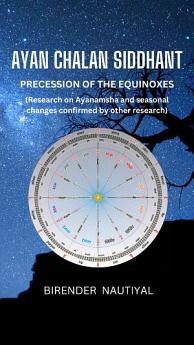AYAN CHALAN SIDDHANT: PRECESSION OF EQUINOXES
About this ebook
Bowing down at the feet of the Lord, in this fourth edition of the book presented after research, I begin the calculation of the ayanamsha and season changes of Satyayuga, Tretayuga, Dwaparayuga and the present Kaliyuga.
On the basis of Ayanamsha, the zodiac sign, degrees etc. of the Sun are known and the Samvat is formed by the change of seasons.
I wanted to present this research done on Ayanamsha and change of seasons in front of you, but confirmation after the research was also necessary, hence many other researches were done to confirm the research which proves this book.
The main reason for naming the book as Ayan Chalan Siddhant is that the Sayan Sun is lagging behind Nirayan Aries zero by a time value of 20.41 minutes every year. It will again be in front of Nirayan Aries zero after a fixed period of 25771 years.
The target of the fixed period is to be accomplished by Ayan movement of 20.41 minutes every year, hence the name of the book has been kept Ayan Chalan Siddhant.
The starting point of Nirayana Aries is at an angular distance of 180 degrees from Chitra Nakshatra. This starting point of Aries is stable. From this fixed point, we calculate the Bhogashas of the planets. On the basis of the planetary positions mentioned in our religious scriptures, it is believed that at the time of the beginning of Satyug, the fixed and moving Bhachakras were together at the starting point of Nirayan Aries. Hence, the main source of the base calculation is the fixed point of Nirayan Aries.
In the beginning of astrological civilization, our scholars and astronomers expanded the calculations by considering the mentioned fixed point as the base, after some years they realized that our base point is not at its place, it has moved a little towards the west from its place. This was called lagging of the Sampaat or movement of Sampaat and the new point was called Char Bhachakra.
To understand Ayanamsha or seasonal change, you have to compare the Earth's annual motion with the Earth's third motion, which is called Ayan Chalan (motion) in this book.
After calculation you will see that just as seasonal changes etc. take place under annual motion, similarly it also takes place under solstice motion, the difference is only of years i.e. nature repeats its rules in micro and long form.
In the annual motion, the Sun starts moving from 21st March i.e. the revolution increases and on 21st June the Sun moves from exactly east direction to a little towards the north direction. It appears that the revolution subsides again from 21st June and from 23rd September, Till then the sun appears to come exactly towards the east.
In the same manner, it starts moving from 23rd September i.e. the revolution increases and on 22nd December, it is a little south of the exact east. Again from 22nd December, the revolution decreases and the Sun seems to come back towards the east and on 21st March, the Sun is exactly in the east direction.
The above means that the Earth makes a complete revolution of 360 degrees around the Sun in its annual motion, during which six seasons change, but it appears to us that the Sun moves a little towards the North from the East and after coming back to the East, moves a little towards the South.
Similarly, Ayanamsha also completes a full revolution of 360 degrees around the fixed star, during which also six seasons change.
The seasonal considerations given by the earlier Acharyas in historical texts confirm the statement that the fixed star is moving towards the west.
From zero degree till completion of 90 degree declination it moves a little towards north and after completing 90 degree it seems to come again towards east for 180 degree declination.
Similarly, from 180 degrees to the completion of 270 degrees declination, it moves a little towards the south and after completing 270 degrees, it again seems to come towards the east for 360 degrees declination.
In annual motion, the earth revolves around the sun and in axial motion, the earth revolves around a fixed star. On the background of both of these is the starting point of Nirayan Aries. This is the base point of calculation. The six seasons keep rotating in front of this point due to the above mentioned two motions.
The period is of Sayan years which are completely divisible by 360 degrees of Bhachakraman, for example if 1728000 Sayan years of Satyayuga are divided by 360 degrees of Bhachakraman, we get 4800 divine years; if 1296000 Sayan years of Tretayuga are divided by 360 degrees of Bhachakraman, we get 3600 divine years; if 864000 Sayan years of Dwaparyuga are divided by 360 degrees of Bhachakraman, we get 2400 divine years; if 432000 Sayan years of Kaliyuga are divided by 360 degrees of Bhachakraman, we get 1200 divine years.
4320000 of one Mahayuga If we divide the Sayan years by 360 degrees of the Bhachakramana then we get 12000 divine years. That is, a year which is completely divided into 360 degrees.
If we multiply the 4320000 years of Mahayuga with the days of Nirayan and Sayan year respectively, then we get the Nirayan and Sayan Ahargan days of a Mahayuga. On subtracting these Ahargans, the Nirayan days of seasonal change remain. On dividing the Nirayan days of seasonal change by the days of Nirayan year, we get the past cycles.
4320000 Sayan years of Mahayuga, we get the year etc. of the gross cycle value.
Example : 4320000×365.256363=1577907488.16 Nirayan Ahargan and 4320000×365.24219=1577846260.80 Sayan Ahargana, difference between both 61227.36 Season change Nirayan Day etc., 61227.36÷365.256363=167.63 Last cycle. 4320000÷167.63=25771.28 Gross Nirayan Chakra, Gross size of one Chakra is 25771.28 The number of years obtained means 167.63 cycles pass in one Mahayuga.
Look carefully at the years of the above periods, the Sayan years of all the periods are zero after decimal point, i.e., the Nirayan and Sayan years start respectively 1st entry starts from Baishakh and Chaitra and 21st March.
In 25771 years from 21st March to 20th March midnight, there are 360 degrees Ayanamsha and 365.256363 seasons change days i.e. the cycle is of 25771 years.
There are a total of eight chapters in this book, each chapter is divided into several parts based on their calculation order. The second, third, fourth and sixth chapters respectively deal with calculation of Satya Yuga, Treta Yuga, Dwapar Yuga and Kali Yuga, their sequential parts such as Ayanamsha calculation, determination of total days of Nirayan month, calculation of seasonal changes, major Nirayan Sankranti calculation, Sayan Sankrantis and fixed Bhachakra, Nirayan and Sayan Samvat, Nirayan and Sayan Sun calculation method, finding Ahargana and day, celestial hemisphere and solstice, Perihelion and Aphelion, are the same on the basis of their respective eras.
In the first part of chapter 1 of elementary calculation, decimal calculation has been given. How to convert amount degrees into amount decimal or degrees decimal is given in detail. By doing reverse calculation, it has been explained how to convert zodiac decimal into zodiac degrees, period etc. Apart from this, by doing reverse calculation, converting year decimal, month decimal and their conversion into year-month etc. has also been explained.
In the 25771 years of Ayan cycle, the total days of Nirayan month keep changing, this has been given in detail in the second part of chapter Elementary calculation.
In the third part, how to calculate 25771 years of cycle, 71.59 years taken in one degrees of Ayanamsha, 70.56 years taken in one day of seasonal change, 50.29 seconds Ayanamsha of one year etc. has been explained in detail.
In the fourth part, the method of making the Ayan Gati Chakra Yantra has also been explained in detail so that if you first make the instrument then it will be easy to take any kind of decision.
In the fifth part of the first chapter, calculations for finding the difference in speed have been given. In this part, speed difference tables of twelve months have been given.
Though all the chapters and their parts are important, but the most important is the fifth chapter and its parts. In its first part, the decision to start Sayan and Nirayan Samvat has been taken.
The calculation of Samvat formation is from the Sun, Sun is always there and will always be there, therefore, the pattern has been considered i.e. the current AD pattern has been used in every period.
In the second part, the method of getting Ganavarsha from Ishtavarsha has been given.
The next 9 parts are similar to the four Yugas starting from Satyayuga mentioned earlier. Thereafter, in other parts, many calculations like beginning of Kaliyug, decision of Kaliyug Samvat, method of finding Kaliyug Navsamvat date at present, current calculation of Kalisamvat period, Kaliyug commencement calculation before Christ etc. have been given in the said book.
The simplest methods have been given in the book but do not even try, i.e. if someone has a habit of running away from the subject of mathematics, he cannot benefit from any method.
Remember! The attainment of any subject can be done only by strong determination rather than education.
HARI OM
Ratings and reviews
- Flag inappropriate
- Flag inappropriate
- Flag inappropriate
About the author
Researcher Introduction
Birender Nautiyal, son of Late Shri Jagdish Prasad Nautiyal, was born on 14th July 1970 in Delhi. Born in a Brahmin family, the researcher originally hails from village Bastang, P.O. Kolakhal, Pauri Garhwal (Uttarakhand). His father, along with working in National Small Industries Building, New Delhi, was also an expert in rituals and astrology mathematics. Therefore, the writer's inclination towards rituals and astrology was natural since childhood.
The author, after voluntarily retiring from the Indo-Tibetan Border Police after serving for 23 years, passed the Jyotish Acharya examination with first division after studying the two-year astrological course conducted by the Institute of Astrology Science located at Bharatiya Vidya Bhavan.
Naturally, while searching for a Guru, during his service in Pithoragarh, he found Late Shri Girish Chandra Joshi Ji as his Astrology Guru. Under his guidance, he has done mathematical work in his three books as assistant writers, namely, “Aayu Nirnaya Shodh-Siddhant evam Prayog”, “Kaalchakra Dasha se Falit” and “Trik Bhaav aur Chandrama”.
His first book as an independent research paper was "Sarlikrit Jyotishiya Gadna" (Google e-book) presented the book “Ayan Chalan Siddhant” It is in your hands.
Hari:Om




